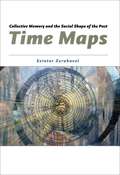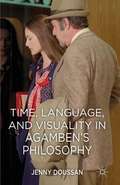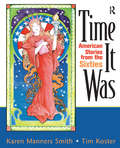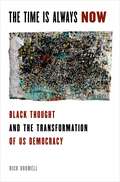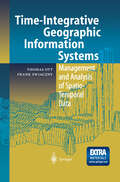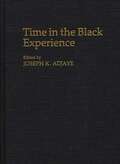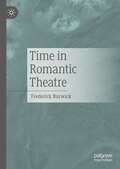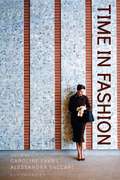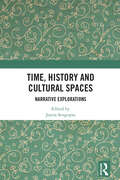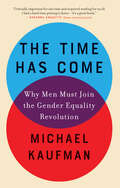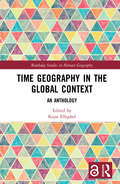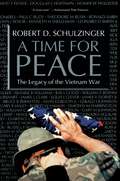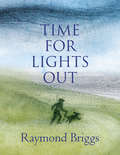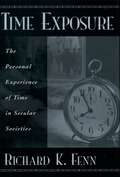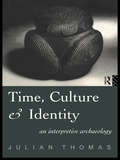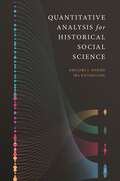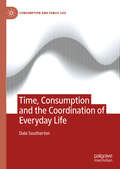- Table View
- List View
Time Maps: Collective Memory and the Social Shape of the Past (The\other Voice In Early Modern Europe Ser.)
by Eviatar Zerubavel"Time Maps extends beyond all of the old clichés about linear, circular, and spiral patterns of historical process and provides us with models of the actual legends used to map history. It is a brilliant and elegant exercise in model building that provides new insights into some of the old questions about philosophy of history, historical narrative, and what is called straight history."-Hayden White, University of California, Santa Cruz Who were the first people to inhabit North America? Does the West Bank belong to the Arabs or the Jews? Why are racists so obsessed with origins? Is a seventh cousin still a cousin? Why do some societies name their children after dead ancestors? As Eviatar Zerubavel demonstrates in Time Maps, we cannot answer burning questions such as these without a deeper understanding of how we envision the past. In a pioneering attempt to map the structure of our collective memory, Zerubavel considers the cognitive patterns we use to organize the past in our minds and the mental strategies that help us string together unrelated events into coherent and meaningful narratives, as well as the social grammar of battles over conflicting interpretations of history. Drawing on fascinating examples that range from Hiroshima to the Holocaust, from Columbus to Lucy, and from ancient Egypt to the former Yugoslavia, Zerubavel shows how we construct historical origins; how we tie discontinuous events together into stories; how we link families and entire nations through genealogies; and how we separate distinct historical periods from one another through watersheds, such as the invention of fire or the fall of the Berlin Wall. Most people think the Roman Empire ended in 476, even though it lasted another 977 years in Byzantium. Challenging such conventional wisdom, Time Maps will be must reading for anyone interested in how the history of our world takes shape.
Time Maps: Collective Memory and the Social Shape of the Past
by Eviatar Zerubavel"Time Maps extends beyond all of the old clichés about linear, circular, and spiral patterns of historical process and provides us with models of the actual legends used to map history. It is a brilliant and elegant exercise in model building that provides new insights into some of the old questions about philosophy of history, historical narrative, and what is called straight history."-Hayden White, University of California, Santa Cruz Who were the first people to inhabit North America? Does the West Bank belong to the Arabs or the Jews? Why are racists so obsessed with origins? Is a seventh cousin still a cousin? Why do some societies name their children after dead ancestors? As Eviatar Zerubavel demonstrates in Time Maps, we cannot answer burning questions such as these without a deeper understanding of how we envision the past. In a pioneering attempt to map the structure of our collective memory, Zerubavel considers the cognitive patterns we use to organize the past in our minds and the mental strategies that help us string together unrelated events into coherent and meaningful narratives, as well as the social grammar of battles over conflicting interpretations of history. Drawing on fascinating examples that range from Hiroshima to the Holocaust, from Columbus to Lucy, and from ancient Egypt to the former Yugoslavia, Zerubavel shows how we construct historical origins; how we tie discontinuous events together into stories; how we link families and entire nations through genealogies; and how we separate distinct historical periods from one another through watersheds, such as the invention of fire or the fall of the Berlin Wall. Most people think the Roman Empire ended in 476, even though it lasted another 977 years in Byzantium. Challenging such conventional wisdom, Time Maps will be must reading for anyone interested in how the history of our world takes shape.
Time Maps: Collective Memory and the Social Shape of the Past
by Eviatar Zerubavel"Time Maps extends beyond all of the old clichés about linear, circular, and spiral patterns of historical process and provides us with models of the actual legends used to map history. It is a brilliant and elegant exercise in model building that provides new insights into some of the old questions about philosophy of history, historical narrative, and what is called straight history."-Hayden White, University of California, Santa Cruz Who were the first people to inhabit North America? Does the West Bank belong to the Arabs or the Jews? Why are racists so obsessed with origins? Is a seventh cousin still a cousin? Why do some societies name their children after dead ancestors? As Eviatar Zerubavel demonstrates in Time Maps, we cannot answer burning questions such as these without a deeper understanding of how we envision the past. In a pioneering attempt to map the structure of our collective memory, Zerubavel considers the cognitive patterns we use to organize the past in our minds and the mental strategies that help us string together unrelated events into coherent and meaningful narratives, as well as the social grammar of battles over conflicting interpretations of history. Drawing on fascinating examples that range from Hiroshima to the Holocaust, from Columbus to Lucy, and from ancient Egypt to the former Yugoslavia, Zerubavel shows how we construct historical origins; how we tie discontinuous events together into stories; how we link families and entire nations through genealogies; and how we separate distinct historical periods from one another through watersheds, such as the invention of fire or the fall of the Berlin Wall. Most people think the Roman Empire ended in 476, even though it lasted another 977 years in Byzantium. Challenging such conventional wisdom, Time Maps will be must reading for anyone interested in how the history of our world takes shape.
Time, Language, and Visuality in Agamben's Philosophy
by J. DoussanGiorgio Agamben, a philosopher both celebrated and reviled, is among the prominent voices in contemporary Italian thought today. His work, which touches upon fields as diverse as aesthetics and biopolitics, is often understood within a framework of Aristotelian potentiality. With this incisive critique, Doussan identifies a different tendency in the philosopher's work, an engagement with the problem of time that is inextricably bound up with language and visuality. Founded in his early writings on metaphysics and continuing to his present occupation with inoperativity, Time, Language and Visuality in Agamben's Philosophy forges an original path through Agamben's extensive commentary on the linguistic and the visual to illuminate the recurrent temporal theme of capture and evasion the cat-and-mouse game that bears the foundational violence of not just representation but concept-formation itself. In the process, Doussan both reveals its limit and establishes a ground for future engagements.
Time It Was: American Stories from the Sixties
by Karen Manners Smith Tim KosterWhat was it like to live through the Sixties? The writers of these 27 memoirs offer the essence of life and youth in the period. In first-person narratives that range from poignant reminiscences to dramatic adventures, the writers convey what it felt like to land a helicopter in the middle of a firefight in Vietnam, to be beaten and jailed for trying to integrate restaurants in the American South, to run for cover when soldiers opened fire on a campus peace rally in Ohio. Other stories describe the writers' experiences organizing farm workers with Cesar Chavez, campaigning to elect Barry Goldwater, striking for Free Speech at Berkeley, living in a commune, joining the women's liberation movement, becoming caught up in a religious cult, or camping in the rain at Woodstock.
Time It Was: American Stories from the Sixties
by Karen Manners Smith Tim KosterWhat was it like to live through the Sixties? The writers of these 27 memoirs offer the essence of life and youth in the period. In first-person narratives that range from poignant reminiscences to dramatic adventures, the writers convey what it felt like to land a helicopter in the middle of a firefight in Vietnam, to be beaten and jailed for trying to integrate restaurants in the American South, to run for cover when soldiers opened fire on a campus peace rally in Ohio. Other stories describe the writers' experiences organizing farm workers with Cesar Chavez, campaigning to elect Barry Goldwater, striking for Free Speech at Berkeley, living in a commune, joining the women's liberation movement, becoming caught up in a religious cult, or camping in the rain at Woodstock.
The Time is Always Now: Black Thought and the Transformation of US Democracy
by Nick Bromell"Why," asks Nick Bromell, "should the political thought of white Americans remain the only theory to which Americans of all ethnicities turn when constructing and reconstructing their understanding of democracy? Must Americans remain locked in an apartheid of experience and perception even after whites have become a minority population in this nation? Hasn't the 2012 presidential election made clear that the time has come to build not just on the votes of citizens of color, but on the varieties of democratic thought their experience has engendered?" In his answers to these questions, Bromell brings to light an underappreciated stream of democratic reflection by black writers and activists from David Walker to Malcolm X. Bromell argues that these thinkers urge Americans to fundamentally re-imagine the nature of their democracy and recognize that indignation can be a powerful and productive democratic emotion; that dignity is just as important to democracy as equality and liberty; that national citizenship can be infused with a sense of responsibility to the world; and that faith can actually promote rather than threaten democratic pluralism. A literary critic and intellectual historian, Bromell draws on a wide range of fiction, essays, speeches, and oral histories, deftly synthesizing recent work in U.S. history, literary and cultural studies, and political theory. Like the figures he discusses, he puts this thought to work in the present moment, this "now." Black democratic insights, he shows, are strikingly relevant to the challenges facing US democracy today, and they provide the basis for a new, post-liberal public philosophy with which to turn back the rise of radical conservatism. Historian Robin D.G. Kelley writes: "In this work of enormous breadth, depth, and imagination, Nick Bromell makes what may be the most original contribution to political theory in the past decade. In this age of alleged color blindness, Bromell has the vision and the chutzpah to turn to African American thought-ideas born of struggle, anchored in questions of dignity, human relationships, and faith-in order to revitalize American democracy. "
Time-Integrative Geographic Information Systems: Management and Analysis of Spatio-Temporal Data
by Thomas Ott Frank SwiacznyTime in the Black Experience (Contributions in Afro-American and African Studies: Contemporary Black Poets)
by Joseph K. AdjayeIn the first book which deals entirely with the subject of time in Africa and the Black Diaspora, Adjaye presents ten critical case studies of selected communities in Africa, the Caribbean, and the American South. The essays cover a wide spectrum of manifestations of temporal experience, including cosmological and genealogical time, physical and ecological cycles, time and worldview, social rhythm, agricultural and industrial time, and historical processes and consciousness. The studies confirm the continuity of temporal experience among Africans from pre-colonial times, through the colonial period in Africa, across continents through slavery and Maroon societies, to present-day communities like the Gullah of the Sea Islands of South Carolina. The subject of time, now recognized to be relative rather than uniform, draws together evidence from a variety of disciplines, specifically history, linguistics, political science, anthropology, and philosophy.
Time in Romantic Theatre
by Frederick BurwickThe shift in temporal modalities of Romantic Theatre was the consequence of internal as well as external developments: internally, the playwright was liberated from the old imperative of “Unity of Time” and the expectation that the events of the play must not exceed the hours of a single day; externally, the new social and cultural conformance to the time-keeping schedules of labour and business that had become more urgent with the industrial revolution. In reviewing the theatre of the Romantic era, this monograph draws attention to the ways in which theatre reflected the pervasive impact of increased temporal urgency in social and cultural behaviour. The contribution this book makes to the study of drama in the early nineteenth century is a renewed emphasis on time as a prominent element in Romantic dramaturgy, and a reappraisal of the extensive experimentation on how time functioned.
Time in Fashion: Industrial, Antilinear and Uchronic Temporalities
by Caroline Evans Alessandra VaccariFew phenomena embody the notion of time as well as fashion. Fast-moving and rooted in the 'now', it's constantly creating its own past through the process of rapid style change. Uniquely poised between the past and the future, fashion's relationship with time is unorthodox. Rather than considering time in the conventional sense, this anthology explores three alternative ways to think about fashion and time: the first identifies the seasonal nature of fashion as an industry, and shows how this has impacted on workers and wearers alike. The second looks at fashion design as a ceaseless process of adaptation, reconstruction and recombination of motifs, in which nostalgia and revivals play their part. The third construes fashion's 'imaginary', with its capacity for fantasy and myth-making, as a form of alternate history that asks 'what if?'Within this framework, key classic texts are juxtaposed with lesser known ones, in an interdisciplinary approach that includes philosophy, history, literature, media and fashion design, ranging from the 18th century to the present. It will be of interest to anyone wishing to understand one of the most complex yet inescapable aspects of fashion, its relationship to time, and will be a critical resource for undergraduate and postgraduate students in the humanities and all those interested in fashion in all its creative, commercial and cultural aspects.
Time in Fashion: Industrial, Antilinear and Uchronic Temporalities
Few phenomena embody the notion of time as well as fashion. Fast-moving and rooted in the 'now', it's constantly creating its own past through the process of rapid style change. Uniquely poised between the past and the future, fashion's relationship with time is unorthodox. Rather than considering time in the conventional sense, this anthology explores three alternative ways to think about fashion and time: the first identifies the seasonal nature of fashion as an industry, and shows how this has impacted on workers and wearers alike. The second looks at fashion design as a ceaseless process of adaptation, reconstruction and recombination of motifs, in which nostalgia and revivals play their part. The third construes fashion's 'imaginary', with its capacity for fantasy and myth-making, as a form of alternate history that asks 'what if?'Within this framework, key classic texts are juxtaposed with lesser known ones, in an interdisciplinary approach that includes philosophy, history, literature, media and fashion design, ranging from the 18th century to the present. It will be of interest to anyone wishing to understand one of the most complex yet inescapable aspects of fashion, its relationship to time, and will be a critical resource for undergraduate and postgraduate students in the humanities and all those interested in fashion in all its creative, commercial and cultural aspects.
Time, History and Cultural Spaces: Narrative Explorations
by Jayita SenguptaThis book brings together critical essays on time, history and narrativity and the explorations of these concepts in philosophy, music, art and literature. The volume provides a comprehensive introduction to narrative theories as well as philosophical discourses on time, memory and the self. Drawing insights from western and eastern philosophy, it discusses themes such as subjectivity and identity in historical narratives, theorization of time in cinema and other arts and the relationship between the understandings of existence, consciousness and concepts such as Kala, Aion, and yugas. The book also looks at the narrativization of history across cultures by exploring modern fiction from China and India, murals of martyrs in Northern Ireland, music and films set against the canvas of the Second World War and the Holocaust, as well as diasporic cultural histories. This book will be an interesting read for scholars and researchers of comparative literature, history, philosophy of history, cultural studies and post-colonial studies.
Time, History and Cultural Spaces: Narrative Explorations
by Jayita SenguptaThis book brings together critical essays on time, history and narrativity and the explorations of these concepts in philosophy, music, art and literature. The volume provides a comprehensive introduction to narrative theories as well as philosophical discourses on time, memory and the self. Drawing insights from western and eastern philosophy, it discusses themes such as subjectivity and identity in historical narratives, theorization of time in cinema and other arts and the relationship between the understandings of existence, consciousness and concepts such as Kala, Aion, and yugas. The book also looks at the narrativization of history across cultures by exploring modern fiction from China and India, murals of martyrs in Northern Ireland, music and films set against the canvas of the Second World War and the Holocaust, as well as diasporic cultural histories. This book will be an interesting read for scholars and researchers of comparative literature, history, philosophy of history, cultural studies and post-colonial studies.
The Time Has Come: Why Men Must Join the Gender Equality Revolution
by Michael KaufmanIn the vein of Tim Wise’s White Like Me and Sheryl Sandberg’s Lean In, The Time Has Come —by co-founder of the White Ribbon campaign Michael Kaufman — offers a plain-spoken and forthright look at why and how men must actively fight for gender equality.From founding the White Ribbon Campaign, the world’s largest organized effort of men working to end violence against women, in the early 1990s, to his appointment as the only male member of the G7 Gender Equality Advisory Council, Michael Kaufman has been a major figure in promoting social justice and women’s rights for decades. Now, in The Time Has Come, he issues a stirring call for men to mobilize in the movement for gender equality.Weaving together sociological data, personal experiences, and insights gleaned from decades of work with governments and NGOs around the globe, Kaufman explores topics ranging from domestic violence to parental leave, grappling with the ways in which a culture of toxic masculinity hurts women and men (and their children). Informative and provocative, The Time Has Come demonstrates how real gender equality creates advancements in both the workplace and the global economy, and urges men to become dedicated allies in dismantling the patriarchy.
Time Geography in the Global Context: An Anthology (Routledge Studies in Human Geography)
by Kajsa EllegårdTime-geography is a mode of thinking that helps us understand change processes in society, the wider context and the ecological consequences of human actions. This book brings together international time-geographic research from a range of disciplines. Swedish geographer Torsten Hägerstrand is a key foundation for this book, and an introductory biography charts the influences that led to the formation of his theories. A central theme across time-geography research is recognizing time and space as unity. Contributions from the Netherlands, the USA, Japan, China, Norway and Sweden showcase the diverse palette of time-geography research. Chapters study societies adjusting to rapid urbanization, or investigate the need for structural changes in childcare organization. The book also delves into green transportation and the interplay between humans and nature in landscape transformation. Applicational chapters look at ICT effects on young people’s daily life and methods for engaging clients in treatment practice. This book situates the outlook for this developing branch of research and the application of time-geography to societal and academic contexts. Its interdisciplinary nature will appeal to postgraduates and researchers who are interested in human geography, urban and regional planning and sociology.
Time Geography in the Global Context: An Anthology (Routledge Studies in Human Geography)
by Kajsa EllegårdTime-geography is a mode of thinking that helps us understand change processes in society, the wider context and the ecological consequences of human actions. This book brings together international time-geographic research from a range of disciplines. Swedish geographer Torsten Hägerstrand is a key foundation for this book, and an introductory biography charts the influences that led to the formation of his theories. A central theme across time-geography research is recognizing time and space as unity. Contributions from the Netherlands, the USA, Japan, China, Norway and Sweden showcase the diverse palette of time-geography research. Chapters study societies adjusting to rapid urbanization, or investigate the need for structural changes in childcare organization. The book also delves into green transportation and the interplay between humans and nature in landscape transformation. Applicational chapters look at ICT effects on young people’s daily life and methods for engaging clients in treatment practice. This book situates the outlook for this developing branch of research and the application of time-geography to societal and academic contexts. Its interdisciplinary nature will appeal to postgraduates and researchers who are interested in human geography, urban and regional planning and sociology.
A Time for Peace: The Legacy of the Vietnam War
by Robert D. SchulzingerThe Vietnam War left wounds that have taken three decades to heal--indeed some scars remain even today. In A Time for Peace, prominent American historian Robert D. Schulzinger sheds light on how deeply etched memories of this devastating conflict have altered America's political, social, and cultural landscape. Schulzinger examines the impact of the war from many angles. He traces the long, twisted, and painful path of reconciliation with Vietnam, the heated controversy over soldiers who were missing in action, the influx of over a million Vietnam refugees into the US, and the plight of Vietnam veterans, many of whom returned home alienated, unhappy, and unappreciated. Schulzinger looks at how the controversies of the war have continued to be fought in books and films and, perhaps most important, he explores the power of the Vietnam metaphor on foreign policy, particularly in Central America, Somalia, the Gulf War, and the war in Iraq. Using a vast array of sources, A Time for Peace provides an illuminating account of a war that still looms large in the American imagination.
A Time for Peace: The Legacy of the Vietnam War
by Robert D. SchulzingerThe Vietnam War left wounds that have taken three decades to heal--indeed some scars remain even today. In A Time for Peace, prominent American historian Robert D. Schulzinger sheds light on how deeply etched memories of this devastating conflict have altered America's political, social, and cultural landscape. Schulzinger examines the impact of the war from many angles. He traces the long, twisted, and painful path of reconciliation with Vietnam, the heated controversy over soldiers who were missing in action, the influx of over a million Vietnam refugees into the US, and the plight of Vietnam veterans, many of whom returned home alienated, unhappy, and unappreciated. Schulzinger looks at how the controversies of the war have continued to be fought in books and films and, perhaps most important, he explores the power of the Vietnam metaphor on foreign policy, particularly in Central America, Somalia, the Gulf War, and the war in Iraq. Using a vast array of sources, A Time for Peace provides an illuminating account of a war that still looms large in the American imagination.
Time For Lights Out
by Raymond BriggsIn his customary pose as the grumpiest of grumpy old men, Raymond Briggs contemplates old age and death… and doesn’t like them much. Illustrated with Briggs’s inimitable pencil drawings, Time for Lights Out is a collection of short pieces, some funny, some melancholy, some remembering his wife who died young, others about the joy of grandchildren, of walking the dog… He looks back at his schooldays and his time as an evacuee during the war, and remembers his parents and the house in which he grew up. But most, like this one, are about his home in Sussex:Looking round this house,What will they say, The future ghosts?There must have been Some barmy old bloke here,Long-haired, artsy-fartsy type, Did pictures for kiddy books Or some such tripe.You should have seen the stuff He stuck up in that attic!Snowman this and snowman that,Tons and tons of tat.
Time Exposure: The Personal Experience of Time in Secular Societies
by Richard K. FennIn his new book, Richard Fenn looks at the way in which we experience time in a secular society. He argues that secularization is virtually synonymous with individualism. Fenn shows that the Church created the idea of individualism through its demysitification of the universe, its insistence on individual self-discipline, and its intensification of individual responsibility for the use of time. Required to take responsibility for his or her own standing in the eyes of God, the individual emerged from the protection of the Church into the full current of time. No longer protected by Providence or connected to Eternity, our lives have become radically temporal and contingent. Fenn explores the modern experience of time, as expressed in such phrases as "wasting time" and "making up for lost time." In particular, he is interested in the idea of waiting, which he believes is a defining characteristic of modern life. He also argues that the secularization of time produced anxiety about death, and shows the various strategies we have created for dealing with this anxiety. Beautifully written and thoughtfully argued, this volume raises the secularization debate to a new level of depth and sophistication.
Time, Culture and Identity: An Interpretative Archaeology (Material Cultures)
by Julian ThomasTime, Culture and Identity questions the modern western distinctions between: * nature and culture * mind and body * object and subject. Drawing on the philosophy of Martin Heidegger, Julian Thomas develops a way of writing about the past in which time is seen as central to the emergence of the identities of people and objects.
Time, Culture and Identity: An Interpretative Archaeology (Material Cultures)
by Julian ThomasTime, Culture and Identity questions the modern western distinctions between: * nature and culture * mind and body * object and subject. Drawing on the philosophy of Martin Heidegger, Julian Thomas develops a way of writing about the past in which time is seen as central to the emergence of the identities of people and objects.
Time Counts: Quantitative Analysis for Historical Social Science
by Gregory Wawro Ira KatznelsonHow to study the past using dataQuantitative Analysis for Historical Social Science advances historical research in the social sciences by bridging the divide between qualitative and quantitative analysis. Gregory Wawro and Ira Katznelson argue for an expansion of the standard quantitative methodological toolkit with a set of innovative approaches that better capture nuances missed by more commonly used statistical methods. Demonstrating how to employ such promising tools, Wawro and Katznelson address the criticisms made by prominent historians and historically oriented social scientists regarding the shortcomings of mainstream quantitative approaches for studying the past.Traditional statistical methods have been inadequate in addressing temporality, periodicity, specificity, and context—features central to good historical analysis. To address these shortcomings, Wawro and Katznelson argue for the application of alternative approaches that are particularly well-suited to incorporating these features in empirical investigations. The authors demonstrate the advantages of these techniques with replications of research that locate structural breaks and uncover temporal evolution. They develop new practices for testing claims about path dependence in time-series data, and they discuss the promise and perils of using historical approaches to enhance causal inference.Opening a dialogue among traditional qualitative scholars and applied quantitative social scientists focusing on history, Quantitative Analysis for Historical Social Science illustrates powerful ways to move historical social science research forward.
Time, Consumption and the Coordination of Everyday Life (Consumption and Public Life)
by Dale SouthertonTime pressure, speed and the desire for instant consumption pervade accounts of contemporary lives. Why is it that people feel pressed for time, in what ways have societies changed to create this condition, and with what implications? This book examines critical contentions in the field of time and society, ranging from the emergence and dominance of ‘clock time’ and time discipline, the time pressures associated with consumer culture, through to technological innovation and the acceleration of everyday lives. Through extensive analysis of empirical studies of the changing ways in which people organise and experience home, work, leisure, consumption and personal relationships, time pressure is shown to be a problem of the coordination and synchronization of activities. Appreciation of temporal rhythms – formed and reproduced through the organisation and performance of social practices – is necessary to tackle the challenges of coordination, and offers new avenues for analysing social issues such as sustainable consumption, health and well-being. This book is essential reading for all of those interested in social change, consumption and time, including researchers and students from across the social sciences.
